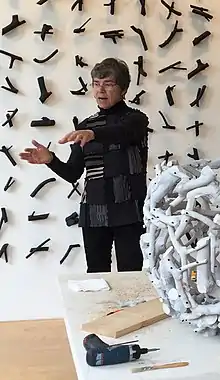Gyongy Laky | |
|---|---|
 | |
| Nationality | American |
| Education | University of California Berkeley |
| Website | https://gyongylaky.com/ |
Gyöngy Laky is an American sculptor living and working in San Francisco, California. Her work has been exhibited in the U.S., Europe, Asia and South America. She gained recognition early in her career for her linear sculptures constructed in the architectural methods of textile arts.[1] “Laky’s art manifests architectonic sensibility. She is as much an engineer as she is an artist in the conventional sense.”[2] She is also known for her site-specific, outdoor, temporary installations.[3]
She expanded the boundaries through the development of dramatic new installations and the use of new kinds of materials. She is particularly well known in the areas of: 1) sculpture; 2) installations; 3) word works; 4) basketry.[4] She has won awards including the National Endowment for the Arts Award of Distinction. Her works are held in the permanent collections of the Smithsonian, the Philadelphia Museum of Art, and the San Francisco Museum of Modern Art, among others. In 2003, The Oral History Center of the Bancroft Library at UC Berkeley, released her oral history.[5] Her personal papers are in the Smithsonian Institution, Washington, DC.[6]
Early life
Born in Budapest, Hungary in 1944, she immigrated to the United States as a young child.[4] She attended public schools in Carmel, California, and received her bachelor's (1970) and master's degree (1971) from the University of California in Berkeley. While a student there, she studied with Ed Rossbach.[7] She spent a year in India studying in the University of California Professional Studies in India Program (1971-1972).[1] Her early life is chronicled in an interview conducted by the Smithsonian.[8]
Fiberworks Center for the Textile Arts
Shortly after her return to the United States from India, she founded Fiberworks Center for the Textile Arts in Berkeley, California in 1973. She played a leading role in the development of the San Francisco Bay Area's prominence in the field.[9] Fiberworks played a pivotal role in the textile arts movement of the 1970s and 1980s, serving as a place where artists could gather, exhibit their work, and learn the skills of this interdisciplinary art form. Laky served as director of the center from its inception in 1973 to 1977.[4] In addition to public classes, artist services and critique groups, the Center established accredited undergraduate and graduate programs in conjunction with Lone Mountain College of San Francisco, California. The Center's gallery was a venue for the emerging avant-garde art. It sponsored gallery exhibitions, both traditional/historic and contemporary. A 1978 three-day Symposium on Contemporary Textile Art was organized by artist Wendy Kashiwa, an event that attracted 475 participants from the United States and abroad.[10] Financial instability threatened the Center's longevity and it was eventually forced to close in 1987.[4] She was also a founding member of the National Basketry Organization.
Professional career
From 1978 to 2005, she served as a faculty member of the University of California, Davis. In addition to teaching, she served as chair during 1995-1997 in the Department of Art. She maintained an art practice in which she was known for her experimentation, risk-taking, and boundary-crossing approach.
References
- 1 2 Koplos, Janet. (2003). Gyöngy Laky. Winchester: Telos. ISBN 1-902015-56-8. OCLC 51235017.
- ↑ Nathan, Harriet, Trapp, Kenneth (2003). Gyongy Laky (b. 1944) Fiber Art: Visual Thinking and the Intelligent Hand. Regional Oral History Office, Bancroft Library, University of California, Berkeley, CA: The Regents of the University of California. p. 248. ISBN 0343021242.
{{cite book}}: CS1 maint: multiple names: authors list (link) - ↑ Meneguzzi, Gabrielle, Sponga, Vincenzo (2016). Humus Park: The Mind Opener (5th ed.). Italy: Commune di Pordenone. pp. 44–45, 82–83.
{{cite book}}: CS1 maint: multiple names: authors list (link) - 1 2 3 4 Koplos, Janet. (2010). Makers : a history of American studio craft. Metcalf, Bruce, 1949-, Center for Craft, Creativity & Design. Chapel Hill: University of North Carolina Press. ISBN 978-0-8078-9583-2. OCLC 658203695.
- ↑ Nathan, Harriet "Gyongy Laky: Fiber Art: Visual Thinking and the Intelligent Hand" Archived 2020-02-24 at the Wayback Machine, Oral History Center, 1998-1999
- ↑ "Gyöngy Laky papers, 1912-2007", Archives of American Art
- ↑ Rossbach, Ed. (1980). The new basketry. New York: Van Nostrand Reinhold. ISBN 0-442-23996-3. OCLC 7746298.
- ↑ Riedel, Mija. "Oral history interview with Gyöngy Laky, 2007 December 11-12". Smithsonian Archives of American Art. Archives of American Art, Smithsonian Institution. Retrieved 16 March 2020.
- ↑ Thalacker, Donald (1980). The Place of Art in the World of Architecture. New York, NY: Chelsea House. p. 142.
- ↑ Cotten, Giselle Eberhard; Junet, Magali (2017). From Tapestry to Fiber Art: The Lausanne Bennials f962 - 1995. Milan Italy: Skira. pp. 78–80. ISBN 978-88-572-3471-7.
External links
- Gyongy Laky's website: https://gyongylaky.com/
- Gyongy Laky Faculty Webpage at UCDavis: https://arts.ucdavis.edu/faculty-profile/gyongy-laky
- Gyongy Laky's work at Browngrotta Arts: http://www.browngrotta.com/Pages/laky.php
- Gyongy Laky's work as displayed in the "Art in Embassies" project of the US State Department: https://art.state.gov/personnel/gyongy_laky/